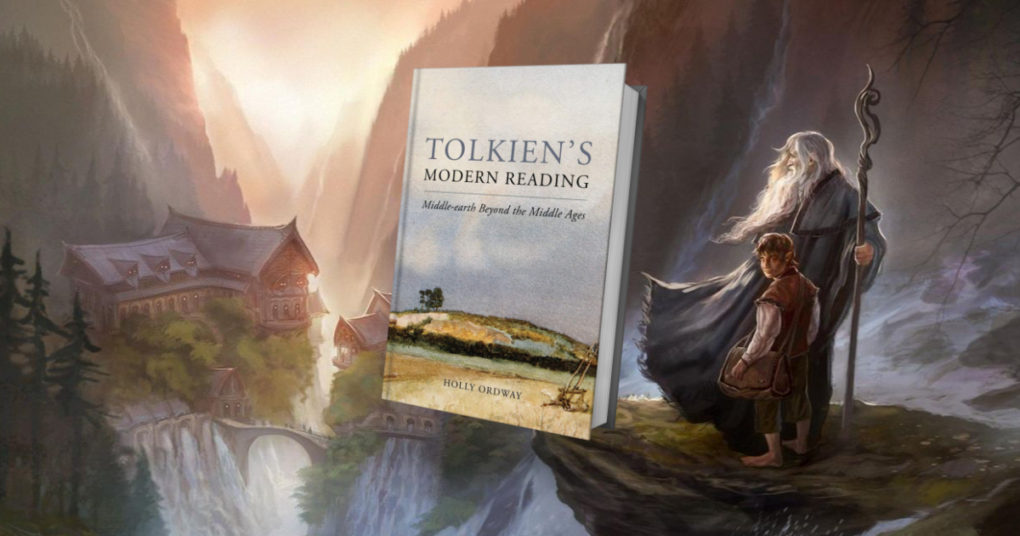Tolkien’s Modern Reading. Middle-earth Beyond the Middle Ages
Holly Ordway
Word on Fire
Park Ridge (Illinois)
2021
382 pages
This book reverses a widespread idea that Tolkien, author of The Hobbit and The Lord of the Rings, “was fundamentally rooted and grounded in the past, partaking only minimally of the modern world, and that we should therefore look to medieval literature for an understanding of his literary creations” (p. 5). Author Holly Ordway was puzzled: why then has Tolkien become so phenomenally popular with modern readers? Are they escaping from reality into a mythical past? Tolkien’s 1977 biographer, Humphrey Carpenter, set out in part to debunk Tolkien’s fame, painting him as opposed to modernity and therefore, by implication, irrelevant to modern man (pp. 10-11).
Ordway, while in no way denying that Tolkien was expert in and in love with the medieval world, proves that Carpenter’s claim that: “the major names in twentieth-century writing meant little or nothing to [Tolkien]. He read very little modern fiction, and took no serious notice of it” is “highly inaccurate” (p. 7).
While confining herself to English language modern fiction between 1850 and Tolkien’s death in 1973 (excluding foreign fiction and all non-fiction) she lists his familiarity with 148 authors and more than 200 works (pp. 275 and 295-305): among them Agatha Christie, James Joyce, E M Forster, Sinclair Lewis, Iris Murdoch. She points out especially Tolkien’s love of children’s books (by the likes of Wyke-Smith, Beatrix Potter, George MacDonald, CS Lewis, Lewis Carroll, William Morris, Arthur Ransome, Kenneth Grahame, JM Barrie), science fiction (Arthur C. Clarke, HG Wells, Asimov, David Lindsay, ER Eddison, CS Lewis), adventure books (SR Crockett, Alexander Macdonald, Rider Haggard, Buchan), poets (Francis Thompson, Longfellow, Coventry Patmore, TS Eliot, Chesterton, Dylan Thomas, Roy Campbell, Matthew Arnold, Auden) and stories of fine fabling (Lord Dunsany, Shorthouse).
The simple conclusion is that Humphrey Carpenter got it wrong.
Ordway uncovers many books, popular a hundred years ago and now largely forgotten (such as Shorthouse’s John Inglesant), and introduces us to the lessons and material Tolkien drew from them.
We find out many things about Tolkien. On apartheid: “I have the hatred of apartheid in my bones” (p. 117). Interestingly, he is also anti-Roman (the pagan Roman Empire) – his Orcs being in some ways linked to Roman soldiers. Though deeply Christian, Tolkien prefers religion in fiction to be unobtrusive (p. 81). Paradoxically, this makes The Lord of the Rings “more thoroughly Christian” (p. 219).
Why did the myth of Tolkien’s anti-modernity come about? Carpenter is to blame, but only partly. Intriguingly, Ordway says some is due to his self-deprecating Englishness. Another reason is that people assume that the close connections between Tolkien and CS Lewis mean that they think the same way. Ordway, in proving that often they did not, defends a vital truth of genuine education: there can be fruitful dialogue with those with whom you disagree. Tolkien was noticeably “catholic” in his openness to ideas that were not his own. He was also opinionated but we are warned against giving too much importance to some of his more forthright opinions. His expressed dislike of Dorothy Sayers’ books didn’t stop him from reading them all (p. 260).
Ordway clearly has learned much from her quest into Tolkien’s modern reading. One feels encouraged to follow her, in her search for the truth and joy in finding it, though this is said quietly so that the reader feels free to follow up the invitation or not.
“Why,” she asks “does Tolkien’s work have such staying power, with its appeal widening and increasing over time?”
Her answer: “I would venture to suggest that it is because his work contains a timeless quality – and that this quality is not a negative one (arising from a total detachment from modern-day concerns), but rather a positive one, deriving from an engagement with the present that is united with a discerning valuation of the past.”
We could say that the ideals of his school society, the T.C.B.S., never left him. They were to “reestablish sanity, cleanliness and the love of real and true beauty in everybody’s breast” (p. 165).
About the Author: Fr Andrew Byrne
Fr Andrew Byrne is a priest of Opus Dei and chaplain to Grandpont House, Oxford.

